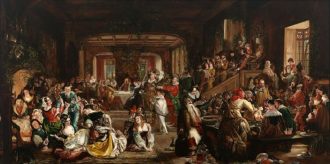‘Merry Christmas in the Baron’s Hall’ - how an Irish artist painted an English Christmas
ToggleArt history offers a unique visual perspective on how Christmas was represented in Britain and Ireland during the nineteenth-century, writes Benjamin Casey, Department of History

Painted by an Irish artist living in London, Daniel Maclise’s 1838 history painting ‘Merry Christmas in the Baron’s Hall’ reveals a unique representation of Christmas. This romantic English depiction of festive celebrations offers viewers with a smorgasbord of figures delighting in celebrations. Maclise portrays a variety of individuals, young and old, engaging in parlour games, feasting on boar’s head and drinking copious amounts of alcohol. Children are painted hiding under tables and young couples are shown amorously holding hands and exchanging notes. Moreover, a band of musicians descend down the stairs playing merry music, all led by Lord Misrule, the person overseeing the revelry. According to Desmond FitzGerald and Anne Crookshank, in their book Irish Painters Maclise’s painting is “full of expression” and is “painted with assurance and clarity”.
However, the Baron, whose hall is the location for these festive celebrations, is ominously depicted in the background along with his family and is separated from the hubbub of the foreground. Justin O’Driscoll, who wrote A memoir of Daniel Maclise describes the Baron as an “old English gentlemen.” Maclise employs this compositional barrier as a visual device to differentiate the two social groups. While this can be seen as an artistic commentary on English class divisions, it leads one to consider how Christmas was celebrated in Ireland.
Smithson notes the impoverished conditions of the Irish “poor” were only highlighted during Christmas. It is apparent that the scenes depicted in the painting are not representative of a typical Irish Christmas celebrated by ordinary people, but are that of a romanticised English Baron inviting his tenants in for a night of jollification. Notwithstanding this, Smithson even notes how “well-off” members of Irish society, “feasted well”, “drank plenty” and danced at grand soirees while the poor suffered in poverty. Interestingly, O’Riordan claims that parties held during the Great Famine of the 1840s “which boasted every delicacy of the season” were not uncommon. O’Riordan adds that members of the upper classes “did not feel themselves bound” to come to the assistance of the “hungry and unemployed”. The irony in all of this is that this painting of an idealised English image of Christmas was concocted by an Irish artist.
The scenes represented in Maclise’s painting must be construed as that of fiction. This is reinforced by literary inspirations that motivated the composition, with constant references to Walter Scott’s poem Marmion: a Christmas poem. Scott’s romantic description of a joyous “pine-built hall” “dress’d with holly green” is representative of an idealised Christmas. Anne Hodge notes how Irish artists like Maclise were held in “high esteem” by the British “art-buying public” and demonstrates the market demand for such images. Fintan Cullen notes that Maclise tended to allow his “Irishness” “to lie dormant” when securing commissions and conformed to a coveted romantic style.
Although Maclise rarely visited Ireland, he retained connection to home by contacting the Irish diaspora in London. According to FitzGerald and Crookshank, Maclise gained a “romantic” and “nostalgic” view of “Ireland’s tragic past”, which is arguably demonstrated by his most famous painting ‘The Marriage of Strongbow and Aoife’. Nevertheless, the imagination on show in Maclise’s Christmas painting was undoubtedly shaped by his close friendship with William Makepeace Thackeray and Charles Dickens, two “literary figures” whose works pioneered our modern conceptions of what Christmas looks like. However, this Victorian and Dickensian perspective of an English Christmas had little in common with what those experiencing poverty in Ireland were enduring.
Ultimately, Maclise’s painting is symptomatic of the artistic trends and conventions of the period. Artworks reflect the cultures that commission their creation. In this case, the romanticism of this English painting is strongly contrasted with the dim reality of social and economic conditions of those down the social ladder in Ireland. Not only were the experiences of those celebrating the festive holidays in Ireland socially stratified, the social divisions between the haves and have-nots became more pronounced. This juxtaposition of Maclise’s idealised English image of Christmas and the cruel reality of Irish poverty encapsulates the social disconnect of Irish-English relations in the nineteenth century.
